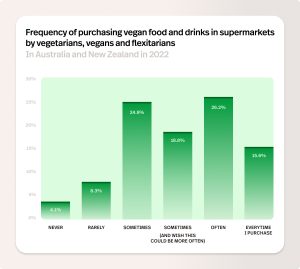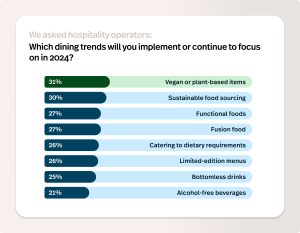
There has been a certain buzz around plant-based foods over the past few years.
Whether you’re catering to seasoned vegans, health enthusiasts, or people just looking to mix up their diets, understanding what plant-based foods are and why they’re gaining popularity is key.
In this blog, we’ll dive into the rise of veganism and explore some intersting findings from our recent Hospitality Report, hinting at a disconnect between what restaurants offer and what customers actually want.
In short, both parties are at opposite ends of the spectrum when it comes to plant-based food.
Let’s dive in.
- What are plant-based foods?
- The rise of veganism
- The growing popularity of plant-based food in Australia
- Benefits of offering a plant-based menu
- A priority for restaurants
- A plant-based divide?
- The normalisation of veganism
- Should you go plant-based?
2024 Hospitality Insights and Dining Dynamics
Lightspeed has surveyed over 500 hospitality operators and more than 1,000 consumers to show you which dining trends are on the rise in 2024. Download the full report for free today.
What are plant-based foods?
Plant-based foods are foods derived from plants, including vegetables, fruits, grains, nuts, seeds and legumes, and do not contain animal products such as meat, dairy, and eggs. These foods have surged in popularity due to their health benefits, environmental sustainability, and the growing interest in vegan and vegetarian diets.
The rise of veganism
Veganism and plant-based foods are commonplace today, with plant-based options on menus nationwide, but it wasn’t always this way.
Until relatively recently, finding something plant-based at a restaurant that wasn’t explicitly vegan was a challenge. Most restaurants shoehorned in an item or two to placate anybody looking for a plant-based meal, and in those times, that was deemed to be enough.
Over the last few years however, there has been a growing demand for more plant-based dishes on menus and this has seen a shift in how restaurants approach building their menus.
There has to be an awareness that more and more people are subscribing to a plant-based, cruelty-free existence and not including their needs on your menu is now a bit of a risky move.
With 42% of Australians either reducing the meat consumption or cutting it out altogether, it makes sense that restaurants need to adapt to cater for such growing demographics. Shifts as large as this hint at these demographics becoming the tastemakers in society, their dollars dictating what is important for businesses to focus on.
The growing popularity of plant-based food in Australia
This shift in practices isn’t limited exclusively to restaurants.
There’s also been a shift in the availability of plant-based and vegan products on supermarket shelves thanks to the advancement in quality of plant-based alternatives to meat, eggs and dairy. Gone are the days of embarking on a treasure hunt in search of plant-based alternatives. Companies like Impossible Foods and Beyond Meat have ensured that plant-based alternatives can command more real estate on supermarket shelves than ever before.
According to Statista, this has seen a rise in the purchasing habits of Australians and New Zealanders when it comes to plant-based and vegan food and drinks.

This has crossed over into the hospitality industry, with businesses of all sizes adopting plant-based alternatives, including Hungry Jack’s, Dominos, KFC, Guzman y Gomez and McDonald’s.
Bars now offer cocktails made with aquafaba (the water in a can of chickpeas) finding that when shaken, it mimics egg whites very closely. Same too with bakeries when they’re after an all-inclusive meringue; aquafaba can be whisked to stiff, white peaks all the same.
Gigi Pizzeria in Sydney made the bold move to switch their entire menu to plant-based, even developing their own plant-based cheeses. Since the switch, they have become a destination for plant-based foodies and inspired a veganism movement amongst similar-minded operators.
Benefits of a plant-based menu
The growing popularity of plant-based and vegan options is obvious, so let’s dig a little deeper into why introducing these options to a menu would appeal to hospitality operators.
1. Attract more customers
Adding plant-based options means you can appeal to vegetarians, vegans, and health-conscious folks, bringing in a wider range of customers.
2. Boost your healthy image
Offering plant-based foods can make your restaurant known for healthy and nutritious meals, which many people are looking for these days.
3. Go green
Plant-based menus are better for the environment since they use fewer resources like water and land and produce less pollution, making your restaurant more eco-friendly.
4. Save on ingredients
Ingredients like beans, grains, and veggies are often cheaper than meat and dairy, which can help you save money and increase profits.
5. Stay trendy
With more people interested in plant-based diets, having these options keeps your restaurant up-to-date with the latest food trends and helps you stand out in a crowded market.
A priority for restaurants
With all of this in mind, it would make sense for restauranteurs to place plant-based items high on their list of priorities for 2024.
This was certainly Lightspeed’s findings in our 2024 Hospitality Insights and Dining Report. We found that amongst hospitality business operators, implementing vegan or plant-based offerings was the top priority for 2024 with 31% of business owners identifying it as most important.

This could be to due to a few reasons.
Firstly, as mentioned earlier, plant-based food is popular with the demographics that make up their core customer base. Satisfying these customers is the smart thing to do and so implementing plant-based offerings into their menus is seen as a bit of a no brainer.
There’s also the storage factor when it comes to plant-based ingredients. In short, their shelf life is usually higher than meat or fish, meaning that wastage is reduced.
A plant-based divide?
Now, this is where things start to get a little more interesting.
The same report found that diners wanted restaurants to focus a lot less on plant-based items, with only 13% flagging it as their top priority for 2024. Taking top spot for diners was sustainable food sourcing, with 34%.

Customers have seen many of their favourite restaurants develop their menus in an effort to be more inclusive of a growing dining demographic by expanding their plant-based offerings.
It’s gotten so normal to include plant-based foods on menus, that much of the fanfare around their arrival has died down, the silence replacing it speaking volumes of just how plant-based foods are here to stay, not as a limited time deal, but as a full-time menu staple.
And this is perhaps why only 13% of diners see it as a priority for 2024.
After all, why keep pushing when you’ve already won?
The normalisation of veganism
This is supported when you take a closer look at what people are searching for.
Over the past 10 years, we can see that there is a gradual rise in interest in vegan food, peaking around late 2019. Since then, there’s been a gradual decline, perhaps signalling that either their desire is waning, or that it’s becoming more a part of everyday life that it’s now something people don’t need to hunt for.

This all suggests that maybe veganism is finally becoming part of everyday life for Australians after spending many a year on the peripherals, straying dangerously close to the realm of taboo.
Should you go plant-based?
The idea that plant-based food is here to stay is there for good reason.
For restaurants it’s a good way to broaden their customer base by offering a more-inclusive menu. Plus, there’s the opportunity to reduce their COGS and wastage with plant-based ingredients being generally cheaper than meat and dairy (seriously, have you bought cheese recently?), and having a longer shelf life.
For customers it’s a good way to broaden their diets and introduce some foods that are more sustainable, that add balance to their diets and offer them a chance at a more guilt free dining experience overall.
2024 Hospitality Insights and Dining Dynamics
For a full breakdown of what customers and operators expect to see in 2024, download the full 2024 Hospitality Insights and Dining Dynamics Report now.

News you care about. Tips you can use.
Everything your business needs to grow, delivered straight to your inbox.


